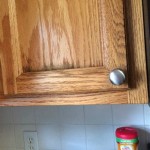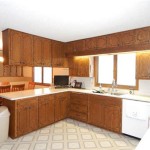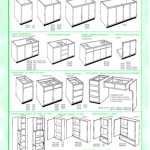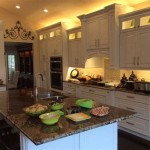How To Paint Black Distressed Kitchen Cabinets
Painting kitchen cabinets black can dramatically transform a kitchen's aesthetic, adding a touch of modern farmhouse charm or a sleek, contemporary feel. Achieving a distressed look adds depth and character, creating a unique, lived-in appearance. This guide provides a detailed process for painting kitchen cabinets black with a distressed finish.
Preparation is Key
Proper preparation is crucial for a successful and long-lasting finish. This stage involves cleaning, degreasing, and creating a smooth surface for the paint to adhere properly. Neglecting this step can lead to peeling and chipping later on.
- Remove Hardware: Start by removing all hardware, including knobs, pulls, hinges, and doors. This allows for complete and even coverage.
- Clean the Surfaces: Thoroughly clean all surfaces with a degreasing cleaner, such as TSP (trisodium phosphate), to remove any grease, grime, or cooking residue. Rinse thoroughly with clean water and allow to dry completely.
- Repair Imperfections: Fill any holes or dents with wood filler and allow to dry according to the manufacturer's instructions. Sand the filled areas smooth with fine-grit sandpaper.
- Sand the Cabinets: Lightly sand all surfaces with fine-grit sandpaper (180-220 grit). This creates a slightly rough surface for better paint adhesion. It's not necessary to remove all the existing finish, just enough to create a good “tooth” for the paint.
- Clean Again: After sanding, clean the cabinets again with a tack cloth or a slightly damp cloth to remove all sanding dust.
- Protect Surfaces: Tape off any areas you don’t want to be painted, such as walls, countertops, and appliances, using painter's tape.
Priming the Cabinets
Primer creates a uniform base for the paint, ensuring consistent color and improved adhesion. It is especially important when painting over darker surfaces or when using a lighter topcoat.
- Choose the Right Primer: Select a high-quality primer designed for wood and suitable for use under your chosen paint. An oil-based primer is often recommended for cabinets that may be exposed to moisture.
- Apply Evenly: Apply the primer using a brush, roller, or sprayer, ensuring an even coat. Avoid pooling or drips.
- Allow to Dry: Let the primer dry completely according to the manufacturer's instructions before applying the topcoat.
Applying the Black Paint
Choosing the right paint and applying it correctly is vital for achieving a smooth, professional-looking finish. Multiple thin coats are preferred over one thick coat for better coverage and durability.
- Choose the Right Paint: Select a high-quality paint specifically designed for cabinets. A satin or semi-gloss finish is generally recommended for kitchen cabinets due to its durability and ease of cleaning.
- Apply Thin Coats: Apply the black paint in thin, even coats using a brush, roller, or sprayer. Avoid overloading the brush or roller, which can cause drips and runs.
- Allow Drying Time: Let each coat dry completely according to the manufacturer’s instructions before applying the next coat. Typically, two to three coats are sufficient.
Creating the Distressed Look
The distressing technique adds character and a vintage feel to the cabinets. This step requires a light touch and careful execution to avoid over-distressing.
- Sanding Technique: Use fine-grit sandpaper (220 grit or higher) to lightly sand along the edges, corners, and raised details of the cabinets. Focus on areas that would naturally experience wear and tear over time.
- Vary the Pressure: Vary the pressure and direction of sanding to create a more natural, uneven appearance. Avoid sanding too aggressively, which can remove too much paint.
- Use a Block for Evenness: Using a sanding block can help maintain even pressure and prevent uneven sanding marks.
Applying a Protective Topcoat (Optional)
While optional, a protective topcoat adds an extra layer of durability to the finish, especially in high-traffic kitchens. This step helps protect the paint from scratches, chips, and moisture.
- Choose a Clear Topcoat: Choose a clear, water-based polyurethane or polycrylic topcoat in either a satin or semi-gloss sheen, matching the sheen of your paint.
- Apply Thin Coats: Apply the topcoat in thin, even coats, using a brush, roller, or sprayer.
- Allow to Dry Thoroughly: Let the topcoat dry completely according to the manufacturer’s instructions before reinstalling the hardware and doors.
Reinstalling Hardware and Doors
Once the paint and topcoat (if used) are completely dry, reinstall the hardware and doors. This completes the transformation of your kitchen cabinets.
- Carefully Reinstall: Reinstall the hardware and doors, ensuring they are properly aligned and secure.
- Touch Up if Necessary: If any areas require touch-ups, do so before reinstalling the hardware.

Rustic Style Really Brings The Excitement To Room It Works Great With Farmhouse And Distressed Kitchen Cabinets

Faux Painting How To Create A Black Rustic Cabinet Finish

Not Sure If I Like Black Distressed Or Kitchen Cabinets

How To Paint Kitchen Cabinets Look Antique

Kaem Org Black Kitchen Cabinets Distressed

Distressing Kitchen Cabinets Before And After Primitive Style Color Black Paint Budget Remodel Cabinet Colors

Kitchen Makeover How To Paint Stylish Distressed Farmhouse Cabinets

Lynda Bergman Decorative Artisan Painting More Black Distressed Cabinets For Lori S Home

Black Distressed Painted Kitchen Cabinets Bella Tucker Decorative Finishes

Kitchen Cabinets With A Distressed Finish Toms River Nj Patch
Related Posts








